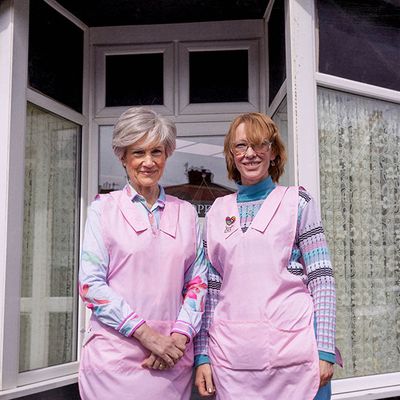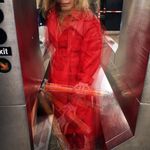
The 1994 BBC Two documentary Three Salons at the Seaside is a delicately rendered slice-of-life that seems modest and quaint but turns achingly bittersweet, drawing out the intimate dynamic between hairdressers and their elderly clientele, many of them widows. Set in Blackpool, a seaside resort town a little north of Manchester, the film has the off-season melancholy of Victor Nunez’s Ruby in Paradise, quietly acknowledging the locals who populate the locale year-round, living modestly on the margins of vacationland. Philippa Lowthorpe’s fly-on-the-wall style picks up on salon-chair anecdotes as delightfully frivolous as a Chinese-food order and as weighty as memories of long-passed husbands and the loneliness that has followed.
Three Salons at the Seaside is only 40 minutes long and currently up on YouTube, and it’s worth seeing just to appreciate how well the wonderful “Two Hairdressers in Bagglyport” mimics not only the look and texture of the documentary, but also tweaks it just enough into the absurd to make it funny. Dame Helen Mirren’s words about Salon de Edwina in the introduction apply to the source material, too: “Not just a place to get your hair done, but a social club, a confessional, and a sanctuary.” The achievement of “Two Hairdressers in Bagglyport” is that it winds up making the same impression as Three Salons, despite qualifying as a parody and slipping in a subplot inspired by a second documentary, 2009’s The September Issue. It’s funny and moving, with an obvious affection for its target.
Of the three salons in Lowthorpe’s original film, Salon de Edwina has been fashioned to look so much like Mary’s Way that it’s as if only the sign was replaced. Succession fans will recognize Harriet Walter as Edwina, a character who’s not entirely removed from the cutting, patrician snob of that show, at least when it comes to maintaining the exacting standards of her annual salon style book. But she’s emotionally generous, too, which explains why she’s hired poor, hapless Alice, whom Cate Blanchett plays like one of the sweetly melancholic zoo animals in Nick Park’s Creature Comforts or a working-class lonely heart in a contemporary Mike Leigh drama. Alice tells the tearful story of losing her husband, a bricklayer, in an incident where he fell off a building while doing his traditional jig on the completion of a job. The whole monologue is a treasure, imagining this celebratory “strut” on the site, but here’s the conclusion:
“The bricks gave way — bricks that he’d laid, it should be said. They gave way and he fell to the ground. The lab said if the fall hadn’t killed him, then hundreds of bricks that came after would have done him in. And when they took him out, he was still clutching that last brick, and I think that speaks to how much he valued his craft.”
So exquisitely pitiable, losing her high-spirited yet incompetent bricklayer of a husband. Edwina assured Alice at the funeral that “we’ll find something for you to do,” but we learn that salonwork is not ideal for Alice, who handles the brush as deftly as her husband handled bricks. (An insert shot of Alice absentmindedly running a faucet-sprayer over a client’s face as Edwina talks about her deficiencies on the job is particularly inspired.) Yet one of the sweet running themes of “Two Hairdressers” is how Edwina and the community around the salon will withstand such quirks out of kindness. Everyone loves Alice, so it doesn’t matter that she isn’t good at her job. And everyone loves the dementia-addled woman who comes in every day and gets treated to a “phantom trim.”
Though Three Salons at the Seaside is entirely responsible for the look and tone of “Two Hairdressers,” the episode’s writer, Seth Meyers, threads in an inspired subplot connected to The September Issue, R.J. Cutler’s behind-the-scenes doc about Anna Wintour and the exacting process behind Vogue magazine’s signature issue. The joke here is that Edwina, while sweet-natured, is so demanding about the quality of the salon’s annual style book that none of the local photographers will work with her anymore. One wedding photographer talks about getting proofs back from Edwina with question marks on some of the shots. Edwina told him the question marks meant, “I couldn’t figure out for the life of me what you were trying to do.”
With no other options, Edwina gives Alice the photography job, setting her up for certain disaster. (When Alice is setting up the equipment, she delights herself by getting punch-drunk off the flashes.) Of course, Alice has all kinds of trouble handling her elderly models. “Think of your husband,” she tells one widow, trying to elicit a smile. “Touch the face part of your face,” she tells another who keeps holding her hand two inches from her right cheek. When Edwina gets to examine the shots, she’s as withering as ever: “Did you shock her by taking your clothes off or something?” “She looks like she’s on drugs.” Alice is grateful for Edwina’s friendship and charity, but she desperately wants to please her, too.
The Wintour plot gives “Two Hairdressers” the strong narrative through-line it needs to string together the vivid, hilarious little anecdotes about the alienating qualities of the new tapas place (“My Kevin ordered the prawns, got three little ones on the plate. Said, ‘I didn’t know I ordered off the children’s menu.’”) or how the salon became an unwitting alibi for the “Plimpton Poisoner” (“If anyone asks, I was in here Friday last.”). When the box of style magazines arrives and a dread-filled Alice cracks it open, the surprise of seeing her face on the cover is a genuinely moving moment. Given the choice between maintaining her exacting standards or giving her friend a lift, Edwina opts to compromise. Her clientele knows what kind of salon she runs, after all. They come for more than a good haircut.
B-Roll
• “When my Thomas came back from the war, he was a totally different man. He was two stone lighter, half a foot taller, his red hair had turned jet black, and he didn’t speak a word of English.”
• Edwina on her cover model Judy: “She died a few months after that picture was taken. Her daughter came up to me at the funeral and said the nicest thing. She said, ‘You made our mom’s hair look nicer than she had ever been to any of us.’”
• This B-Roll is all quotes, but there’s just too much funny stuff here. Like this monologue from a widow reflecting on her late husband’s final days: “When my husband fell ill, the doctors said he only had a week to live, but I wouldn’t listen. I knew he was a fighter. I was with him every night, holding his hand. And then after a week, he became so still, so quiet. His hand was ice-cold. And they told me it was because he had, in fact, passed. But I still wouldn’t listen. I said I wanted to take him home with me, where he could get proper attention. And then would you believe he sat bolt upright? And I probably shouldn’t tell you what he said … He screamed, ‘Shit!’ Then right after that, ‘Piss!’ It was nice to hear his voice again. Then right after that, he died for certain. On that we were all in agreement.”
• Edwina’s logbook denoting her clients and the names of their late husbands is funny in itself, but it’s also a fine callback to Three Salons at the Seaside, which really does have a high number of widowed women.




